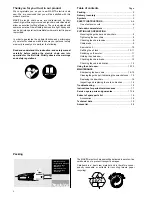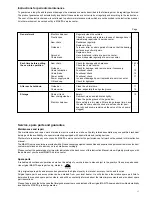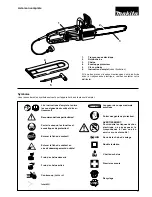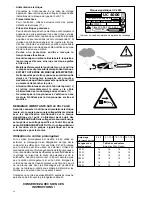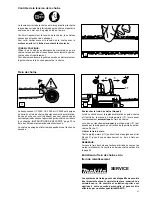
12
Checking the chain lubrication
J
7
I
Checking the chain brake
Do not work with the chain saw without first checking
the chain brake!
-
Start the motor as described (make sure you have a good
footing, and place the chain saw on the ground in such a
way that the guide bar is free of contact).
-
Grasp the tubular handle firmly with one hand and hold the
grip with the other.
-
Switch on the motor and press the hand guard (I/7) in the
direction of the arrow with the back of your hand until the
chain brake engages. The chain should stop immediately.
-
Switch the motor off Immediately and release the chain
brake.
IMPORTANT: If the saw chain does not stop instantly
when you carry out this test, do not under any circum-
stances use the saw! Take the chain saw to a MAKITA
service center.
Never saw when a sufficient chain lubrication is not guaranteed.
Otherwise the life of the sawing device will be reduced. Before
starting work check the oil level in the tank and the oil feeding.
Check the fed oil quantity by following the instructions below:
-
Start the electric chain saw.
-
Hold the running chain saw approx. 15 cm above a trunk
or the ground (use an appropriate surface).
If the lubrication is sufficient, you will see a light oiltrace
because oil will be centrifuged from the chain saw.
Using the chain saw
Always be sure of your footing and hold the chain saw
firmly with both hands while the motor is running.
Felling a tree
When bucking and felling operations are being performed by
two or more persons, at the same time, the felling operation
should be separated from the bucking operation by a distance
of at least twice the height of the tree being felled. Trees should
not be felled in a manner that would endanger any person,
strike any utility line or cause any property damage. If the tree
does make contact with any utility line, the utility company
should be notified immediately.
The chain saw operator should keep on the uphill side of the
terrain as the tree is likely to roll or slide downhill after it is
felled.
A retreat path should be planned and cleared as necessary
before cuts are started. The retreat path should extend back
and diagonally to the rear of the expected line of fall as shown
in Fig. A. The next working place is at least 2 tree lengths
away.
Before felling is started, consider the natural lean of the tree,
the location of larger branches and the wind direction to judge
which way the tree will fall. Remove dirt, stones, loose bark,
nails, staples, and wire from the tree where felling cuts are to
be made.
Notching undercut
Make the notch 1/3 the diameter of the tree, perpendicular to
the direction of fall as shown in Fig.B. Make the lower hori-
zontal notching cut first. This will help to avoid pinching of
either the saw chain or the guide bar when the second notch
is being made.
45
°
45
°
= felling operation
2 tree lengths
Retreat
A
B
2 inches
2 inches
Notch
Hinge
Direction
of fall
Felling back cut


